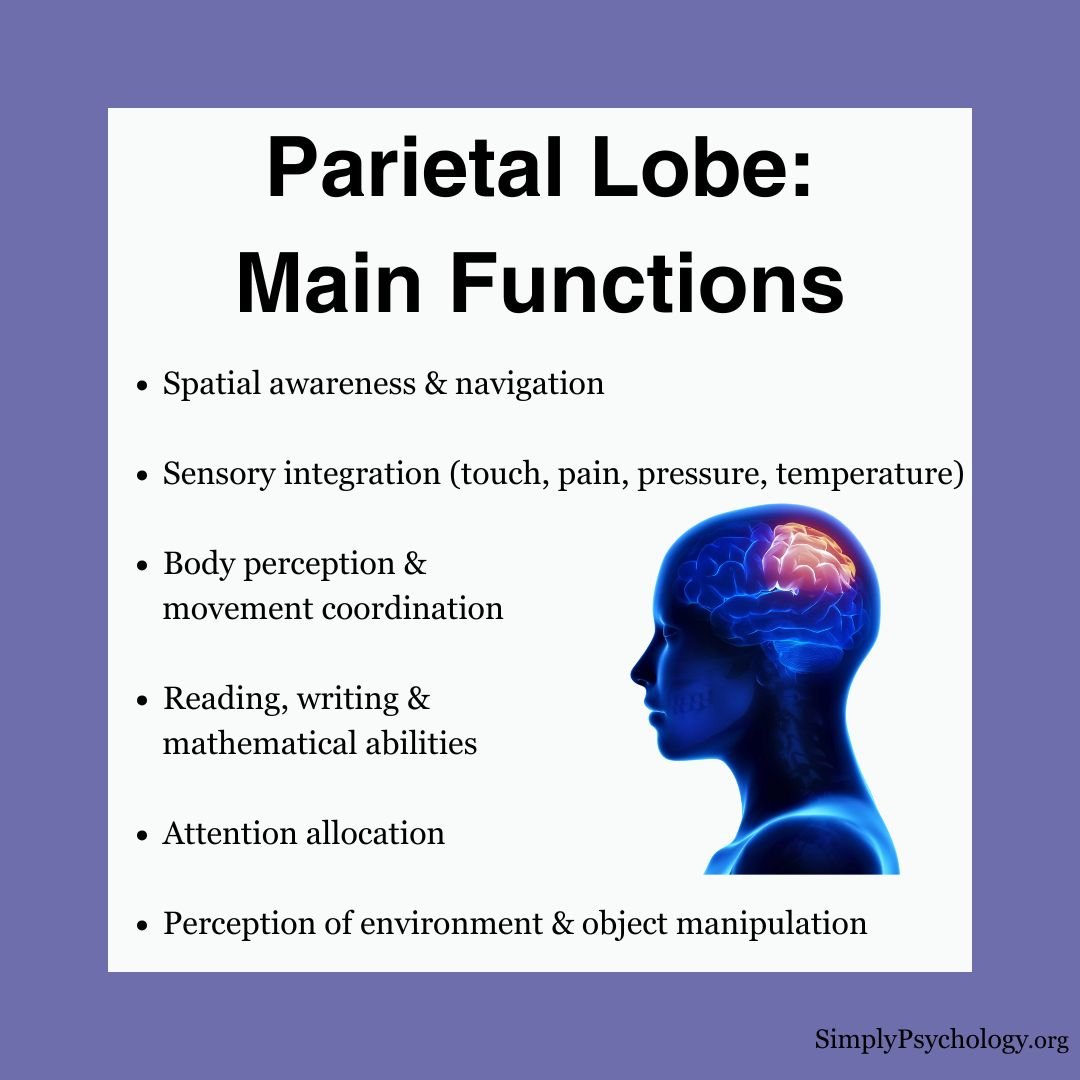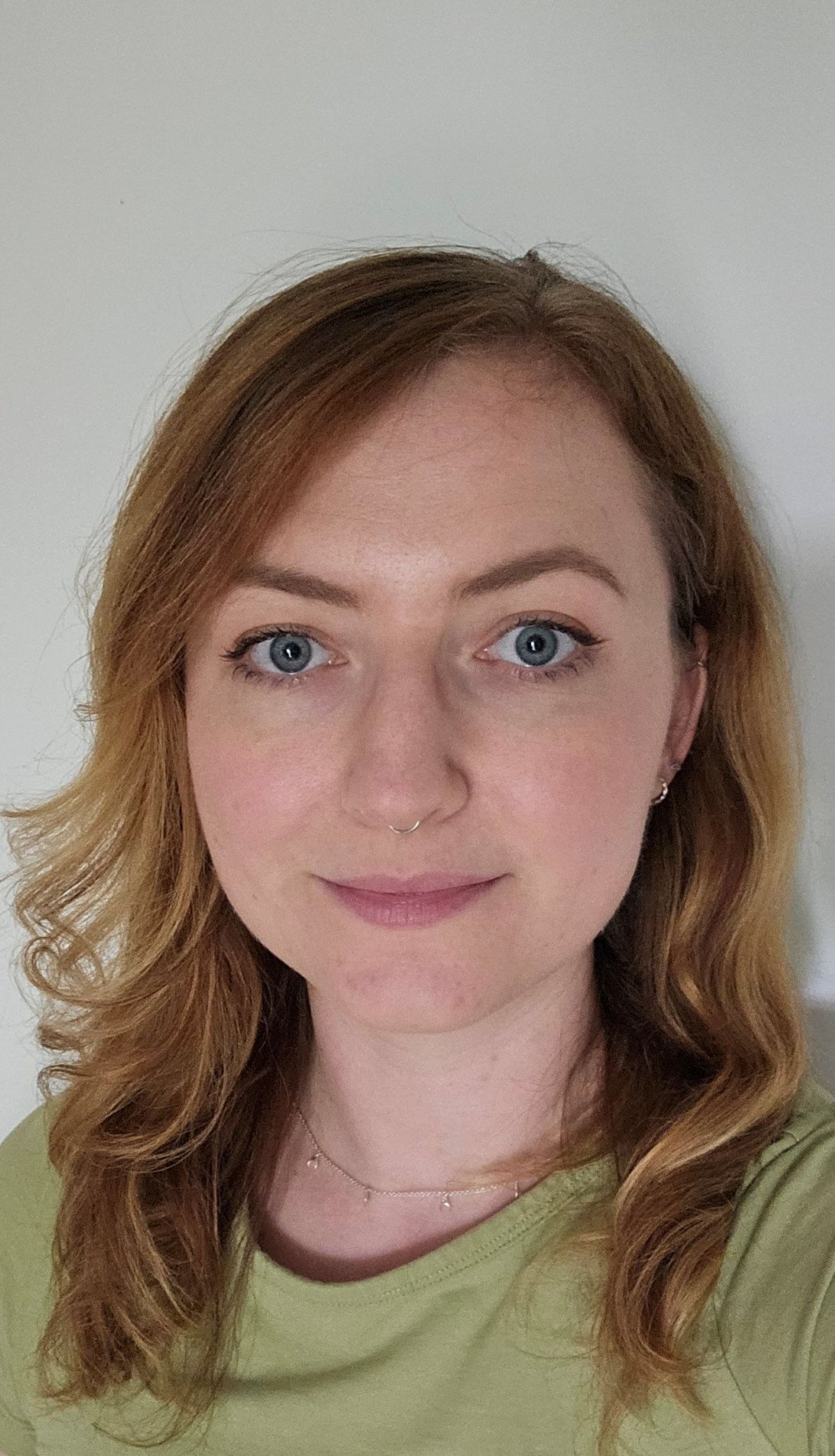The parietal lobe, located in the upper middle part of the cerebral cortex, plays a central role in integrating sensory information from various body parts, understanding spatial orientation, and processing information about touch.

The parietal lobe is crucial for tasks such as attention, spatial reasoning, and distinguishing between self and others, thereby influencing perception and interpersonal interactions.
What does the parietal lobe do?
The parietal lobe plays a crucial role in integrating sensory information from various modalities and is associated with several key functions:
Spatial Awareness and Navigation
- The parietal lobe helps us perceive and navigate our environment by creating spatial maps and representations of the world around us.
Sensory Integration and Processing
- The parietal lobe combines information from different senses—like touch, temperature, pain, and pressure—into a single, unified experience. This helps you recognize what you’re feeling and where it’s happening.
- It also supports multisensory integration, allowing your brain to blend touch, vision, and movement—for example, helping you reach for your phone in the dark using feel alone.
Body Perception and Movement
- It contributes to the perception of the body and coordinates movement.
- The left side of the parietal lobe is believed to keep track of the location of moving body parts.
Language and Mathematics
- The parietal lobe is involved in reading, writing, and number representation (mathematics).
How Your Parietal Lobe Works Behind the Scenes
- Folding laundry without watching your hands? Your parietal lobe helps you track finger movements and feel fabric textures to match socks or smooth out a shirt.
- Navigating a dark room? It lets you gauge space and position using memory, touch, and subtle feedback from your muscles.
- Reaching for a glass without knocking over the salt shaker? That’s spatial awareness and coordination in action—skills your parietal lobe fine-tunes constantly.

Where is the parietal lobe located?
The brain’s parietal lobe is situated between the frontal and occipital lobes and above the temporal lobes. The parietal lobes take up premises in the brain’s right and left hemispheres.
It makes up about 19% of the brain’s cerebral cortex and is made up of neurons that send or relay signals to other neurons, and glial cells, that support the neurons.

Substructures of the Parietal Lobe
The parietal lobe is structurally divided into the somatosensory cortex, inferior parietal lobe, superior parietal lobe, and precuneus.
Somatosensory Cortex
The somatosensory cortex’s main function is to receive and process sensory information from the entire body, such as touch, temperature, and pain.
It creates a representational map of the body within the brain and is responsible for localizing sensations, perceiving different degrees of pressure, and recognizing the shape and texture of objects through touch.
Damage to this area could result in difficulties in perceiving touch and recognizing objects by touch.
How Does Your Brain Know What You’re Holding?
Imagine reaching into your bag or pocket to find your keys without looking. You can feel the shape, texture, and size—and somehow, you just know when you’ve got them. That’s your parietal lobe at work.
This brain region processes touch, pressure, and spatial awareness, allowing you to recognize objects by feel alone. It creates a “map” of your body and surroundings, helping you interact with the world—without needing to rely on sight.
Inferior Parietal Lobe
The inferior parietal lobe is primarily concerned with language, mathematical operations, and body image.
It is also important for spatial attention, visuomotor, and auditory processing, and has been suggested to be involved in the perception of emotions through facial expressions.
Damage to this area may result in impairments in speech repetition and difficulty completing mathematical problems.
Superior Parietal Lobe
The superior parietal lobe is concerned with spatial orientation and sensorimotor integration, and it receives a lot of visual and sensory signals from the hands.
Damage to this area may result in the inability to recognize objects by touch and hemispatial neglect, which is a deficit in attention and awareness of one side of the field of vision.
Precuneus
The precuneus is located on the medial surface of the parietal lobes and is one of the least accurately mapped areas of the cortex.
Functional neuroimaging suggests that the precuneus is involved in tasks such as visuospatial imagery, episodic memory retrieval, and the ability to take first-person perspectives.
This area is also thought to play a role in self-awareness and consciousness.

What Happens When the Parietal Lobe is Damaged?
Damage to the parietal lobes, which can result from conditions like stroke, vascular disease, tumors, traumatic brain injury, or infections, can lead to a variety of symptoms:
- Hemispatial neglect: inability to locate/recognize objects, events, and body parts
- Visual attention deficits and difficulty discriminating sensory information
- Disorientation, lack of coordination, and impaired spatial awareness
- Impaired reading, writing, and drawing abilities without speech deficits
- Mathematical difficulties (acalculia) and language disorders (aphasia) from left-side damage
- Gerstmann’s Syndrome: trouble identifying body parts, left/right distinction, math, reading, writing
- Right-side damage: perceptual deficits integrating parts into wholes and spatial skill issues
- Right-side damage: self-care difficulties, impaired construction tasks, and contralateral neglect
Research has provided further insights into parietal lobe damage:
- Fridriksson et al. (2010) found that damage to the left inferior parietal lobes can impair speech repetition.
- Freund (2003) showed that anterior parietal damage can weaken motor control, while posterior damage affects virtually all aspects of somatosensory function.
- Zhou et al. (2007) found that gray and white matter volume reductions in parietal regions are common in schizophrenia and may account for some symptoms.
- Functional neuroimaging suggests the precuneus is involved in visuospatial imagery, episodic memory retrieval, first-person perspective, self-awareness and consciousness (Cavanna & Trimble, 2006).
Overall, parietal lobe damage can significantly impact an individual’s perception, sensory integration, spatial awareness, language, and cognitive abilities, with distinct deficits arising from left versus right-side lesions.
Ongoing research continues to elucidate the complex functions of this brain region.
References
Cavanna, A. E., & Trimble, M. R. (2006). The precuneus: a review of its functional anatomy and behavioural correlates. Brain, 129(3), 564-583.
Ferro, A., Bonivento, C., Delvecchio, G., Bellani, M., Perlini, C., Dusi, N., Marinelli, V., Ruggeri, M., Altamura, C., Crespo-Facorro. & Brambilla, P. (2017). Longitudinal investigation of the parietal lobe anatomy in bipolar disorder and its association with general functioning. Psychiatry Research: Neuroimaging, 267, 22-31.
Freund, H. J. (2003). Somatosensory and motor disturbances in patients with parietal lobe lesions. Advances in Neurology, 93, 179-193.
Fridriksson, J., Kjartansson, O., Morgan, P. S., Hjaltason, H., Magnusdottir, S., Bonilha, L., & Rorden, C. (2010). Impaired speech repetition and left parietal lobe damage. Journal of Neuroscience, 30(33), 11057-11061.
Lou, H. C., Luber, B., Crupain, M., Keenan, J. P., Nowak, M., Kjaer, T. W., Sackein, A. A. & Lisanby, S. H. (2004). Parietal cortex and representation of the mental self. Proceedings of the National Academy of Sciences, 101 (17), 6827-6832.
Milner, A. D. (1998). Streams and consciousness: visual awareness and the brain. Trends in Cognitive Sciences, 2 (1), 25-30.
Radua, J., Phillips, M. L., Russell, T., Lawrence, N., Marshall, N., Kalidindi, S., El-Hage, W., McDonald, C., Giampietro, V., Brammer, David, A. S. & Surguladze, S. A. (2010). Neural response to specific components of fearful faces in healthy and schizophrenic adults. Neuroimage, 49 (1), 939-946.
Torrey, E. F. (2007). Schizophrenia and the inferior parietal lobule. Schizophrenia Research, 97 (1-3), 215-225.
Vance, A., Silk, T. J., Casey, M., Rinehart, N. J., Bradshaw, J. L., Bellgrove, M. A., & Cunnington, R. (2007). Right parietal dysfunction in children with attention deficit hyperactivity disorder, combined type: a functional MRI study. Molecular Psychiatry, 12 (9), 826-832.
Weiskrantz, L. (1977). Trying to bridge some neuropsychological gaps between monkey and man. British Journal of Psychology, 68 (4), 431-445.
Zhou, S. Y., Suzuki, M., Takahashi, T., Hagino, H., Kawasaki, Y., Matsui, M., Seto, H. & Kurachi, M. (2007). Parietal lobe volume deficits in schizophrenia spectrum disorders. Schizophrenia Research, 89 (1-3), 35-48.

